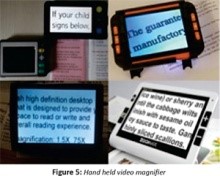
LOW VISION MANAGEMENT
Vision loss that cannot be corrected by ordinary eyeglasses, contact lenses, medication or surgery. Many devices are available to help people with low vision including magnifiers, Telescopes, reading glasses and closed-circuit television devices and etc.
Low vision is a term that denotes a level of vision that is 6/18 or worse and cannot be fully corrected with conventional glasses. Low vision is not the same as blindness. Unlike a person who is blind, a person with low vision has some useful sight. However, low vision usually interferes with the performance of daily activities, such as reading or driving. A person with low vision may not recognize images at a distance or be able to differentiate colors of similar tones.
Vision loss that cannot be corrected by ordinary eyeglasses, contact lenses, medication or surgery. A person with low vision has extremely limited sight that interferes with daily activities.
Low vision should not be confused with blindness. People with low vision have some useful vision which can often be improved with low vision aids. Visual impairment may be mild or severe. Low vision usually results in reduced central or reading vision, but may also result from decreased side (peripheral) vision, a loss of color vision, or an inability to properly adjust to light, contrast or glare.
Many aids are available to help people with low vision including magnifiers, reading glasses and closed-circuit television devices and etc.
CONDITIONS AND SYMPTOMS
Macular degeneration
diabetic retinopathy
cataracts,
glaucoma,
optic nerve atrophy,
retinal detachment,
vision loss due to stroke are some of the conditions that respond to our low vision rehabilitation services.
. We can help If you have any of the following symptoms – .
- Difficulty reading small print
- Blurred distance vision
- Sensitivity to glare
- Poor night vision
- Difficulty performing daily activities such as walking, cooking
LOW VISION ASSESSMENT AND REHABILITATION
LOW VISION TREATMENT OPTIONS
It is a common misconception that enhancing impaired vision is just a matter of increasing the power of glasses. For any distance there is an optimal lens that focuses the image on the retina. A stronger lens will blur the image at distance and is therefore unhelpful. The exception is for near vision tasks. When print is brought closer to the face, it is larger and stronger bifocals or readers can sometimes be used to bring this close object into sharp focus; this will improve only reading vision.
Optical aids work in patients with low vision by increasing the image size on the back of the eye (the retina) so that objects appear larger. There really are no “magic glasses,” only low vision aids. The optical low vision devices for near vision often differ from devices used for distance vision. However, similar factors apply to the selection of visual aids at all distances.
IDENTIFICATION OF REQUIRED TASKS
Fine and gross motor skills : Although there was some decrease in tactile sensitivity, this did not impair his ability to manipulate low vision aids.
Eye dominance : Use of his dominant right eye was precluded initially because this eye was substantially worse affected. Ultimately, his right eye became the better eye.
Monocular vs binocular : Dr. Cole functioned better initially with low vision aids using his left eye alone, and later with his right.
Referred retinal locus : When central vision is damaged by retinal disease, such as with Dr. Cole’s diabetic macular edema, a new area of maximal (albeit reduced) retinal sensitivity can develop. With training and practice, the patient can learn to develop and use this new preferred retinal loci of highest sensitivity, called the PRL, to enhance visual functioning. In the initial stage of low vision management the development of a PRL was prevented by his persisting diffuse macular edema.
Lighting : The level of illumination is often critical in the use of low vision aids. Some individuals require extra illumination while others do not. Augmented illumination is commonly provided by illuminated hand or stand magnifiers.
LOW VISION DEVICES
With the proper devices and training in their use, many individuals are able to continue working, taking public transportation, cooking, sewing, and, in some cases, they may even continue driving. Low vision aids fall into two major categories: optical and prescribed devices and electronic aids.
DISTANCE VIEWING DEVICES

BINOCULAR TELESCOPES

TELESCOPES
READING DEVICES
MOUNTED TELESCOPES
 MAGNIFYING GLASSES
MAGNIFYING GLASSES
MOUNTED LOUPES
MAGNIFIERS
 READING TELESCOPES
READING TELESCOPES
 MAGNIFYING GLASSES
MAGNIFYING GLASSES
MOUNTED LOUPES
 READING TELESCOPES
READING TELESCOPES
 COMPUTER MAGNIFICATION SOFTWARE
COMPUTER MAGNIFICATION SOFTWARE
 PATIENT USING A HAND-HELD CAMERA
PATIENT USING A HAND-HELD CAMERA
 PATIENT USING A CCTV
PATIENT USING A CCTV
 PATIENT USING A HEAD-MOUNTED CAMERA
PATIENT USING A HEAD-MOUNTED CAMERA
Optical Devices for Near & Distance
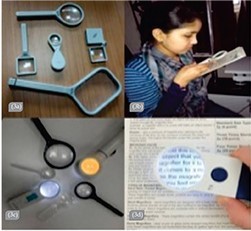
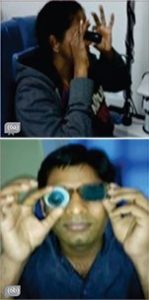
Non Optical Devices
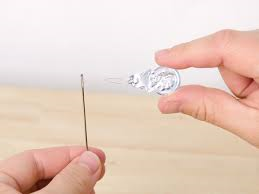
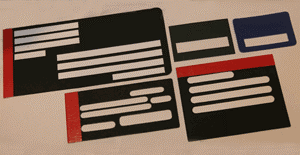
Electronic Devices
